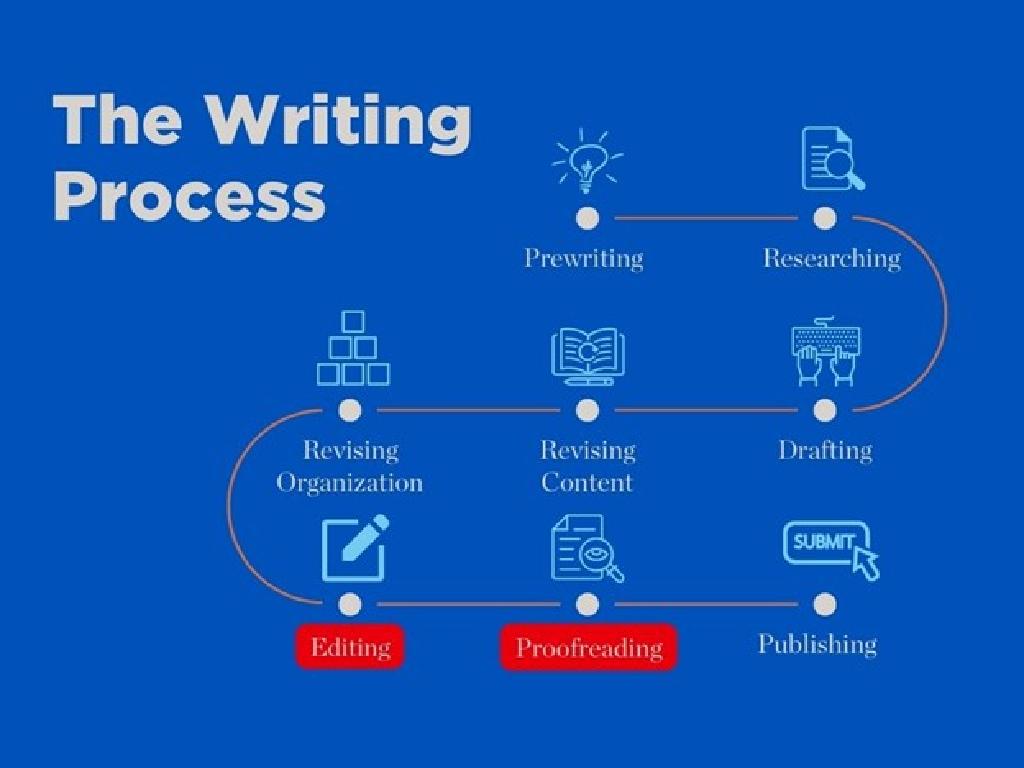Identify Ecosystems
Subject: Science
Grade: Third grade
Topic: Ecosystems
Please LOG IN to download the presentation. Access is available to registered users only.
View More Content
Welcome to Ecosystems!
– What’s an ecosystem?
– A community of living things & their environment
– Types of ecosystems
– Forests, oceans, deserts, and ponds
– Ecosystems we see daily
– Parks, gardens, and even your backyard!
– Importance of ecosystems
|
This slide introduces the concept of ecosystems to third-grade students. Begin by explaining that an ecosystem is a community where living things like plants, animals, and insects live together and interact with their environment, which includes the air, water, and soil. Highlight different types of ecosystems such as forests, oceans, deserts, and ponds to show variety. Give relatable examples like local parks, gardens, or backyards as ecosystems they encounter every day. Emphasize the importance of ecosystems in supporting life and maintaining balance in nature. Encourage students to think about how different living things might depend on each other and their surroundings to survive. This will set the foundation for further discussions on how ecosystems function and the roles of different organisms within them.
What Makes an Ecosystem?
– Ecosystems: Living things included
– An area’s plants, animals, and microorganisms
– Plants, animals, and tiny organisms
– From trees and birds to bacteria
– Non-living elements are key too
– Sunlight, air, and temperature matter as well
– Rocks, soil, and water
– These form the ecosystem’s foundation
|
This slide introduces students to the concept of ecosystems, emphasizing that they consist of both living and non-living components. Explain that living things include all sizes of organisms, from the largest animals to the smallest bacteria. Non-living things like rocks, soil, and water are also essential as they provide the environment in which living things exist. Discuss how these elements interact to form an ecosystem. Use examples like a forest, a desert, or a pond to illustrate different types of ecosystems and encourage students to think of other examples they may be familiar with.
Exploring Different Ecosystems
– Ecosystems are diverse
– Examples: Forests, deserts, oceans
– Think of rainforests, sandy deserts, deep oceans, and cold arctic zones
– Each has unique life forms
– A desert ecosystem has cacti and camels, while oceans have fish and coral reefs
– Plants and animals vary by ecosystem
|
This slide introduces students to the concept of ecosystems, emphasizing the variety and uniqueness of each type. Explain that an ecosystem is a community of living organisms in conjunction with the nonliving components of their environment, interacting as a system. Provide vivid examples of different ecosystems, such as the lush greenery and diverse wildlife of forests, the extreme conditions and specialized life in deserts, the vast and mysterious ocean habitats, and the frigid, ice-covered arctic regions. Highlight how each ecosystem supports different kinds of plants and animals that are adapted to survive in those specific conditions. Encourage students to think about what makes each ecosystem unique and how the living and nonliving elements interact within it.
Living Together in Ecosystems
– Ecosystems: Plants & animals depend on each other
– An ecosystem is like a big family where everyone helps each other.
– Plants give food & oxygen to animals
– Like how trees give us apples to eat and air to breathe!
– Animals spread seeds & pollinate flowers
– Bees and birds move pollen or seeds to help more plants grow.
|
This slide introduces the concept of interdependence within ecosystems, emphasizing the mutual relationships between plants and animals. Explain that an ecosystem is a community where every living thing plays a role and relies on others for survival. Use simple examples like how we need trees for fruit and clean air, and how animals like bees and birds help plants grow by moving pollen and seeds. This will help students understand the balance of nature and the importance of every organism in an ecosystem. Encourage students to think of other ways animals and plants might help each other.
Ecosystems are Homes
– Ecosystems as habitats
– A habitat is a home in an ecosystem where plants and animals live.
– Habitats offer essentials
– They give animals what they need: food, water, shelter, and space.
– Animals have unique homes
– Different animals live in different habitats like forests, deserts, or oceans.
– Survival in different habitats
– Each habitat meets the unique needs of the animals living there for survival.
|
This slide introduces the concept of ecosystems as homes or habitats for various organisms. It’s important for students to understand that a habitat is more than just a place to live; it provides all the essentials an organism needs to survive, such as food, water, shelter, and space. Emphasize the diversity of habitats and how different animals are adapted to live in specific environments. Use examples like fish living in water because they need gills to breathe, or polar bears in the Arctic where they can blend in with the snow. Encourage students to think about their own homes and what they need to live comfortably, drawing parallels to how animals also need certain conditions in their habitats.
Balanced Ecosystems
– What makes an ecosystem healthy?
– Resources for all organisms
– Water, food, and shelter are resources needed.
– Impact of changes in ecosystems
– If one species overpopulates, it can unbalance everything.
– Balance is key to ecosystem health
|
This slide introduces the concept of a balanced ecosystem to third-grade students. A healthy ecosystem is one where there is a balance, meaning that all living organisms have enough resources such as water, food, and shelter to survive. Emphasize the interdependence of organisms within an ecosystem and how changes to one part can affect the whole system. For example, if there are too many predators, they might eat too many prey, which could lead to a shortage of food for the predators later on. Encourage students to think of an ecosystem like a community where everyone has a role and needs to live in harmony. Discuss with students how human activities can impact ecosystem balance and what actions we can take to protect our environment.
Our Impact on Ecosystems
– Humans affect ecosystems
– Negative impacts: pollution & deforestation
– Examples: Litter in oceans, cutting down forests
– Construction can damage habitats
– Building homes removes animal homes
– We can protect ecosystems
– Recycle, plant trees, save water
|
This slide aims to educate third-grade students on the various ways humans can impact ecosystems, both negatively and positively. It’s crucial to discuss the consequences of pollution, such as litter in oceans, and deforestation, which involves cutting down trees and can lead to loss of animal habitats. Highlight how construction for human needs can also damage natural habitats. Emphasize the importance of taking action to protect our ecosystems, such as recycling, planting trees, and conserving water. Encourage students to think of ways they can help in their daily lives and understand that even small actions can make a big difference.
Class Activity: Create Your Ecosystem
– Build a mini ecosystem
– Gather containers, soil, plants
– Use clear containers to see layers
– Add water to your ecosystem
– Water is essential for life
– Choose living and non-living parts
– Rocks, sticks, and insects are examples
|
This hands-on activity is designed to help students understand ecosystems by creating their own in a controlled environment. Provide each student or group with a clear container to observe their ecosystem’s layers. Guide them to fill the container with soil and plant seeds or small plants. Teach them the importance of water and have them gently add it to their ecosystem. Encourage them to think about the living components, like plants or insects, and non-living elements, such as rocks, sticks, or sand, they want to include. Possible activities include creating different ecosystems to compare desert, forest, and aquatic environments. This will help them grasp the concept of ecosystems and the balance between living and non-living things within them. Ensure safety when handling soil and insects. The goal is for students to learn about ecosystems by interacting directly with the components that make them up.





